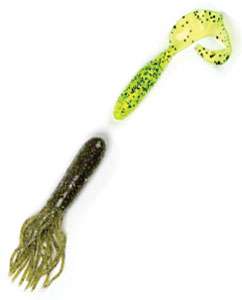
Veteran Canadian bass fishing guide Jon Bondy remembers a day on Lake St. Clair about 10 years ago that totally changed the way he looked at soft plastic baits. He was fishing tubes with a couple of clients for postspawn smallmouth in relatively shallow water, but one of his customers wasn't a very good angler and couldn't get the hang of it. So, Bondy cut off the tube, rigged up a jighead with a curled-tail grub and handed it to the fellow.
"I told him to just cast it out and reel it in, don't do anything with it, don't even let it hit the bottom, just reel it in with a steady medium retrieve," the 35-year-old Bondy, the only Canadian fishing the Elite Series, recalled. "I figured at least he'd have a chance to catch something and he wouldn't have to go home skunked. First cast he caught a fish. Then he caught another. Then another. Before you know it, he was outfishing us 3-to-1, just reeling that grub in.
"It was immediately postspawn, prime smallmouth water, great for tube fishing, but those fish wanted that grub more than they wanted that tube," Bondy continued. "And from then on, I've used that technique to load the boat. There's about a two-week time frame — during the immediate postspawn — when a grub outfishes the tube 3-to-1."
Bondy isn't alone. Lots of anglers have found this curled-tail, old-fashioned offering has a place in the modern tacklebag.
Thirty years ago, grubs were standard fare for bass anglers under a handful of circumstances. Wherever a faster, bottom bouncing bait than the standard Texas rigged plastic worm was needed, a grub on a jighead was the go-to option.
Then in the mid-1980s, Gitzit showed up and tubes became all the rage. By the '90s, tubes had pretty much replaced grubs as the main alternative to a Texas rigged worm and have become the standard for any situation where it isn't too snaggy or weedy for an open-hooked bait.
But with the recent popularity of swimbaits — which are essentially oversized grubs with flat, perpendicular tails — anglers are rediscovering other grub styles.
Mark Zona, co-host of ESPN television's The Bassmasters, is a confirmed tube fanatic, but there are times, he says, when a grub will outperform his preferred go-to bait.
Zona says he always starts the year — as soon as the ice is off the lakes up where he lives in Michigan — with a grub, usually a simple spade-tailed model (like the old Mann's Sting Ray Grub) because of its subtle action.
"I want a bait with absolutely no action at ice-out," says the 35-year-old Zona. "In cold water — and I mean absolutely brutally cold water: 33, 34, 35 degrees — it is frightening how well they'll eat that spade-tailed grub."
Tubes, in contrast, have more built-in action, Zona says: The undulating tails keep moving even when the bait is sitting still on the bottom. So, Zona never goes to the tube unless the water's at least 45 degrees, and even then he'll experiment with the tube to see what the fish want.
In contrast to Zona, who says he goes back to the tube when the water temperature hits 55 degrees, Bondy will fish a grub until the water gets much warmer. Bondy goes to a grub as a change-of-pace bait when the fish are getting used to seeing a lot of something (such as a spinnerbait) or when the fish are suspended.
Whenever Mark Zona's planning on bumping bottom with a jighead in spring or fall, he lines up four baits — a tube and three different grubs — and rotates lures until he finds out what the fish want.
"A lot of times when the fish are up in the water column, I snap that grub off the bottom really hard — especially when it's flat calm — and bring it up through a school of fish and they'll just go nuts," he said. "The problem is when you do that with a tube, you get a lot of line twist. And most of the time you're doing that with a spinning rod and reel, which is naturally twisty, anyway. So, you use a grub instead of a tube and you eliminate a lot of the problems, and most importantly, you can catch a bunch of fish."
Bondy warns, however, that anglers must pay attention to how they're rigging the grub, and small details make a lot of difference.
"You want a round-ball jighead with a long shank hook," he said. "Use a jighead with an eyelet that sits tight against the lead. You don't want one with a long eyelet — it catches on grass. A small eyelet will come through the stuff in the water a lot better. And you want the grub body on the hook straight so it doesn't twist your line."
Always rig a curled-tail grub with the tail pointed down, Bondy says, so it undulates freely without bumping into the hook.
And I like a tail that's as thin as possible — you get more action with a thin tail," he said.
There's one last advantage to a grub, Bondy says: It's faster than a tube.
You don't have to retie every time the bait gets torn up," Bondy said. "With a tube, you have to cut the line, insert the jighead into a new tube and retie; when you're busy trying to catch them, you don't have time for all that.
"That's especially so for smallmouth. Sometimes it takes awhile to get them started and when you do, you've got to keep them going. If you give them five minutes to cool down while you're retying a tube bait, they'll quit. You've got to get it right back out there, right away.




